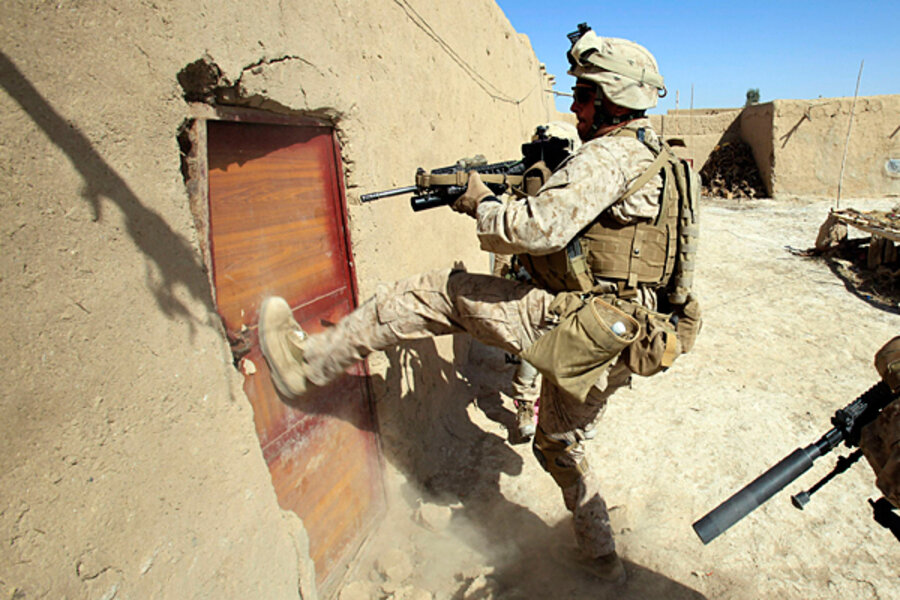Afghanistan war: Taliban hiding behind civilians in Marjah
Loading...
| Kabul, Afghanistan
Amid intelligence reports alleging that Taliban insurgents are holding civilians as hostages, American and Afghan forces moved cautiously through the Taliban stronghold of Marjah on Tuesday as they pressed the biggest offensive since the U.S. landed troops in Afghanistan more than eight years ago.
The U.S.-led International Security Assistance Force (ISAF) had issued an apology Sunday for the deaths of 12 civilians who were killed in Marjah, saying that an American rocket "failed to hit intended target" and struck a house 300 yards away. U.S. and Afghan forces in a mixed unit had come under sustained fire before American troops fired the rocket.
However, Afghanistan's interior minister, Hanif Atmar, gave a different account Monday, saying that the dead civilians were being held as hostages.
"The Taliban were attacking (the soldiers) from five places. We took a decision to hit the fort (house) but we didn't know they had civilian hostages," Atmar said at a news conference in Lashkar Gah, the capital of Helmand province.
The ISAF later suggested that the coalition's initial apology had been in error. Coalition investigators now think that the rocket hit its target and three insurgents died in the strike in addition to the 12 civilians, ISAF officials said. They're trying to determine whether those Taliban were holding the civilians prisoner.
The soldiers "were taking fire from the house that was hit. In fact there was fire coming from five separate houses, (but) unclear if this was one enemy moving back and forth or five different fire points," said a senior ISAF official, who spoke only on the condition of anonymity because the information wasn't yet authorized for release.
[The commander of Britain's forces in southern Afghanistan told reporters Tuesday, via video link in Afghanistan, that the missile that struck the house killing 12 people, including six children, had hit the intended target. Maj. Gen. Nick Carter said that the rocket had not malfunctioned nor been incorrectly targeted, according to the Associated Press.]
Before the operation began, the ISAF had picked up some intelligence that the Taliban planned to detain civilians at gunpoint, ISAF officials said. Now, anecdotal evidence suggests that the Taliban in Marjah are trying to force their way into civilian homes. Taliban who've been taken prisoner will be interrogated to see whether they can provide information on possible hostages.
Human shields for Taliban
"We had intelligence reports going into this that not only were there immense amounts of bombs, IEDs" — improvised explosive devices — "and booby traps out there, we understood people were held against their will," the senior ISAF official said.
"We believe the objective there is to create those as human shields or — in the worst-case scenarios — maybe even as false civilian casualties. If we don't create them (civilian casualties), they might create them," the official added.
There were further indications that Taliban fighters may be taking refuge in the homes of residents and setting them up as human shields. The ISAF announced Monday that it had killed three other civilians accidentally in the previous 48 hours in Operation Moshtarak, which means "together" in the Dari language. One of the dead men was "inside a building that was used by insurgents" during an engagement, the ISAF said.
The U.S.-led international force has targeted erroneously on many occasions, but it's tried to minimize civilian casualties in an effort to win popular support for its campaign against the Taliban. Separately, an airstrike Monday against suspected militants in the neighboring province of Kandahar killed five civilians instead, the ISAF announced.
Avoiding civilian casualties is the touchstone of the three-day-old operation, which is intended to showcase the new American approach to Afghanistan of protecting the civilian population while eliminating the biggest Taliban stronghold in southern Helmand province.
Stanley McChrystal, the American general who heads the international force, acknowledged the civilian risk Monday.
"When President Karzai empowered us to conduct this operation, he gave us some very specific guidance, and that guidance was to continue to protect the people of Afghanistan, and so this operation is done with this in mind," McChrystal said at the news conference in Lashkar Gah.
The Taliban are adept at using the issue of civilian casualties as propaganda against the foreign forces in the country.
(Shah is a McClatchy special correspondent.)
MORE FROM MCCLATCHY
U.S. apologizes for killing of 12 Afghan civilians





